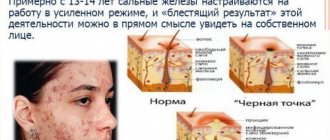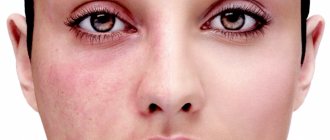Allergic cough
An allergic cough is not a disease, but only a specific manifestation of an allergy. This cough is called the “cough variant of bronchial asthma” and is a symptom of a general allergic disease. An allergic cough can occur when allergens affect the upper respiratory tract . This type of cough is directly related to inflammation in the bronchi, trachea and mucous membrane of the throat.
Video - diagnosis and treatment of allergies, 12:17 min
An allergic cough most often occurs in paroxysms, starting suddenly, a person literally coughs. Typically, an allergic cough lasts 14-21 days and is not accompanied by an increase in temperature, but can easily be accompanied by a runny nose. The cough appears mainly at night, and stops during the day. The cough is dry, but may be accompanied by sputum, which is clear and free of pus. An allergic cough may also be accompanied by an itchy throat, nose, or sneezing.
The causes of allergic cough are different and depend largely on the type of allergy . Most often, this is a typical allergy to dust, flowering plants (hay fever), animals, or the body’s reaction to a foreign protein that could be in the body with a vaccine, serum or plasma.
What is the fundamental difference?
- Both a pediatrician and an allergist-immunologist will confirm that allergic coughs are rarely accompanied by sputum production and are often paroxysmal in nature.
- Before an attack, the child experiences difficulty breathing, shortness of breath due to swelling of the bronchial mucosa.
- The disease does not depend on air temperature, whereas the symptoms of bronchitis or whooping cough usually develop during the cold season.
- Antihistamines can stop an attack, while their use for bronchitis or tracheitis does not provide improvement.
- In this case, there is practically no elevated temperature.
Sometimes it is possible to draw parallels and determine what exactly caused the attack. This could be a walk in the park where the child inhaled pollen, playing with a four-legged pet, or a pillow if the deterioration occurs at night.
Symptoms of an allergic cough
Any allergic cough is a cough that will not go away if the cause of its occurrence is not eliminated. Allergic cough can occur at different times of the year and can be caused by different irritants and for different reasons.
It is sometimes very difficult to recognize an allergic cough in the fall, since it is not at all different from a typical cough during a cold, and is often accompanied by rhinitis. In this case, coughing attacks appear unexpectedly, a spasm of the larynx is noted, and there may be convulsions. The main method of combating allergic cough is to eliminate the causes that caused such manifestations.
House dust, animal hair, pollen - inhaling these particles can also cause an allergic cough. To determine the exact cause of an allergic cough, you should consult an allergist, who will conduct a series of tests and do test tests for allergens.
When an irritant acts on the respiratory system, swelling forms in the mucous membrane of the bronchi and larynx, the symptom of which is mild suffocation. To get rid of the irritant, a person begins to cough frequently, in this natural way, our body protects itself from various allergens.
Pathogenesis
An allergic cough develops when an allergen enters the respiratory tract, and in response to this, class E immunoglobulins are produced. Basophils, eosinophils and mast cells are of great importance in the development of respiratory allergosis. They are the components of the inflammatory reaction in the bronchi. During allergic reactions, histamine is produced in high concentrations. This powerful mediator causes a wide range of effects: increased vascular permeability, contraction of smooth muscles, itching. The biochemical interaction of histamine with immunoglobulin E proceeds as an avalanche-like chain reaction, so an allergic reaction quickly appears and develops with great speed.
The mucous membrane of the bronchial tree is characterized by pronounced edema, while mucus secretion is disrupted and sputum transport worsens.
There are three phases in the pathogenesis of immune inflammation.
- Immunological . It is associated with the interaction of the allergen with macrophages - this produces specific antibodies. B lymphocytes synthesize IgE, which circulates in the blood and is deposited on mast cells and smooth muscles.
- Pathochemical reaction . At this stage, the leading role is given to mast cells (basophils). histamine and tryptase are released 20 minutes after interaction with the allergen during degranulation . After 2-5 hours, second-order mediators ( thromboxanes , leukotrienes , prostaglandins ) are released.
- Pathophysiological phase . During this phase, under the influence of inflammatory mediators, the bronchi are damaged - capillary permeability increases, cellular infiltrates are formed and edema develops. At this stage there are already clinical manifestations, which is associated with increased bronchial reactivity and narrowness of the airways (the obstructive component increases).
Allergic cough in children
Such a concept as an allergic cough in children occurs more often than one might think at first glance.
This disease is especially typical for those children who suffered from diathesis at an early age. Such children have an allergic predisposition and an allergic cough in such children can be caused by even a small amount of allergens. Improper diet and late vaccine administration can also cause allergic cough in children. The most important sign of an allergic cough in children is a dry cough. The symptoms of an allergic cough usually worsen seasonally, mainly in winter and summer, since in winter a lot of time is spent in a confined space, and in summer many plants bloom and various unintended contacts are typical. Treatment of allergic cough in children is carried out by an allergist and an immunologist.
Persistent coughing attacks in children should alert parents. It is possible that these are symptoms of bronchial asthma. There are enough reasons for its appearance: frequent viral infections, hereditary predisposition and unfavorable environmental factors, constant contact with the allergen.
An allergist begins treatment of allergic cough in children by determining the causes. It is possible that the cough may be caused by pollen or house dust mites, or by your new perfume, your favorite cat or the neighbor's dog. When the initiator is identified, the allergist prescribes effective treatment for the child .
Diet
Hypoallergenic diet
- Efficacy: therapeutic effect after 21-40 days
- Timing: constantly
- Cost of products: 1300-1400 rubles. in Week
With food allergies, patients must strictly adhere to a hypoallergenic diet . However, for other allergic diseases, highly allergenic foods must be excluded from the diet. The diet should be complete in terms of protein (110-120 g), fat (120 g) and carbohydrates (200 g). The diet should be rich in vitamins, so it is important to diversify the diet with permitted fruits, berries, vegetables and their juices. You should limit salt, salty foods (marinades, pickles, sausage, dried fish, cheese) and smoked foods, which increase allergic manifestations.
Products that often cause allergies are excluded:
- citrus;
- nuts;
- Fish and seafood;
- eggs;
- smoked meats;
- mayonnaise, ketchup, mustard;
- tomatoes;
- mushrooms;
- eggplant;
- Strawberry wild-strawberry;
- pineapple, melon;
- chocolate;
- coffee;
- honey.
Limit the consumption of confectionery and sugar.
Patients' diets may include:
- rabbit, veal, beef;
- cereal and vegetable soups, cabbage soup, beetroot soup;
- vegetable oil and butter;
- plums, prunes, cherries, pears, watermelon, gooseberries, cranberries, blueberries, green apples;
- potatoes, all types of cabbage, zucchini, beets, dill, parsley, onions, pumpkin, seasonal cucumbers;
- dairy products;
- buckwheat, rice and oatmeal porridge;
- black and white bread, lean dry bread, homemade pies without eggs.
Treatment of allergic cough
The ENT-Asthma clinic has developed a unique program for the treatment of allergic cough in both adults and children. Before starting treatment, a set of diagnostic tests is performed to show the current state of respiratory functions. Depending on the indications, computer bronchophonography may be prescribed, a procedure for obtaining an assessment of the activity of allergic processes in the bronchi, as well as a general diagnosis of respiratory dysfunction.
Our clinic employs highly qualified allergists who have many years of experience in treating allergic cough, which is confirmed by numerous reviews from our patients. If necessary, patients are observed by specialist doctors at the ENT-Asthma clinic in order to monitor the dynamics of recovery during the therapy. Come to our appointment and see for yourself the effectiveness of our methods.
Prevention
Prevention of this disease in children and adults includes:
- Elimination of dust sources (books, carpets, feather pillows, plush toys).
- Regular wet cleaning using safe household chemicals.
- Intensive ventilation of the room.
- Air humidification and ionization.
- Do not use air fresheners or aerosol perfumes.
- The use of hypoallergenic cosmetics.
- Minimize contact with animals.
- During the flowering of herbs, reduce the time spent in the air, do not open windows in the apartment during this period, use nasal filters or medical masks.
- Change a profession associated with occupational hazards.
- During pregnancy and breastfeeding, exclude highly allergenic foods from the diet.
- If you have a food allergy, stick to your diet.
Cost of treatment
| Name | Cost, rub. | |
| 1 | Initial appointment with a doctor, doctor of medical sciences | 7500* |
| 2 | Procedures included as prescribed by a doctor: | |
| UZIS | 2700 | |
| Ozone ultraviolet sanitation | 450 | |
| Laser photoreactive therapy | 1800-2600 | |
| Application of a microcompress into the nasal cavity | 700 | |
| Application of gum-propolis suspension to mucous membranes | 600 | |
| 3 | Final examination by a doctor based on the results of treatment | 1000 |
* — When paying for the full course of treatment procedures, the cost of a doctor’s appointment is included in the amount of treatment. The course of treatment is prescribed by a doctor. The course duration is 7-12 sessions depending on the diagnosis.
Providing emergency medical care for acute allergic diseases
Ph.D.
A.V. Topolyansky, professor A.L. Vertkin Scientific Center for Children's Health of the Russian Academy of Medical Sciences, Moscow MMA named after I.M. Sechenov MGMSU named after. ON THE. Semashko Station of ambulance and emergency medical care, Moscow National Scientific and Practical Society of Emergency Medical Care, Moscow
P
According to the National Scientific and Practical Society of Emergency Medical Services, over the past 3 years the number of calls for acute allergic diseases in the Russian Federation as a whole has increased by 18%. Moreover, their frequency in different regions ranges from 1 to 5% of all cases of emergency medical team visits.
Main causes and pathogenesis
The pathogenesis of allergic reactions has been studied quite fully today and is described in detail in many domestic and foreign monographs on allergology and clinical immunology. In any case, in the tissue of the shock organ or the “target” organ, which can be the skin, bronchi, gastrointestinal tract, etc., signs of allergic inflammation appear. The central role in the implementation of these immunopathological reactions belongs to class E immunoglobulins
(IgE), the binding of which to the antigen leads to the release of allergy mediators (histamine, serotonin, cytokines, etc.) from mast cells.
Most often, allergic reactions develop when exposed to inhaled allergens in homes, epidermal, pollen, food allergens, medications, parasite antigens, as well as stings and insect bites. Drug allergies most often develop when using analgesics, sulfonamides and antibiotics from the penicillin group, and less often cephalosporins. In addition, the incidence of latex allergy is high.
Clinical picture, classification and diagnostic criteria
From the point of view of providing assistance and assessing the prognosis, acute allergic diseases can be classified as follows (Table 1):
Lungs
– allergic rhinitis (year-round or seasonal), allergic conjunctivitis (year-round or seasonal), urticaria.
Moderate to heavy
– generalized urticaria, angioedema, acute laryngeal stenosis, moderate exacerbation of bronchial asthma, anaphylactic shock.
The greatest concern when providing medical care at the prehospital stage should be caused by prognostically unfavorable cases of development of life-threatening conditions in patients: severe asthma attack (status asthmaticus), anaphylactic shock, Quincke's edema in the larynx, acute laryngeal stenosis.
When analyzing the clinical picture of an allergic reaction, the emergency physician should receive answers to the questions presented in Table 2.
The initial examination should assess for the presence of: stridor, dyspnea, wheezing, dyspnea, or apnea; hypotension or syncope; changes on the skin (urticaria-type rashes, Quincke's edema, hyperemia, itching); gastrointestinal manifestations (nausea, abdominal pain, diarrhea); changes in consciousness. If the patient has stridor, severe shortness of breath, hypotension, arrhythmia, convulsions, loss of consciousness or shock, then this condition is considered life-threatening.
Treatment of acute allergic diseases
In case of acute allergic diseases at the prehospital stage, emergency therapy is based on the following areas:
Stopping further entry of the suspected allergen into the body
. For example, in case of a reaction to a drug administered parenterally or to an insect bite/sting, apply a tourniquet above the injection or sting site for 25 minutes (every 10 minutes, loosen the tourniquet for 1–2 minutes); to the injection or bite site - ice or a heating pad with cold water for 15 minutes; pricking at 5–6 points and infiltrating the injection or bite site with 0.3–0.5 ml of 0.1% epinephrine solution with 4.5 ml of isotonic sodium chloride solution.
Antiallergic therapy (antihistamines or glucocorticosteroids)
.
The administration of antihistamines is indicated for allergic rhinitis, allergic conjunctivitis, and urticaria. Glucocorticoid therapy (GCS) is carried out for anaphylactic shock and angioedema (in the latter case, the drug of choice): prednisolone
(adults - 60-150 mg, children - at the rate of 2 mg per 1 kg of body weight).
For generalized urticaria or when urticaria is combined with Quincke's edema, betamethasone
1-2 ml intramuscularly is highly effective. In case of angioedema, to prevent the effect of histamine on tissues, it is necessary to combine new generation antihistamines (loratadine) with glucocorticoids.
Symptomatic therapy
. With the development of bronchospasm, inhaled administration of b2-agonists and other bronchodilators and anti-inflammatory drugs through a nebulizer is indicated. Correction of arterial hypotension and replenishment of circulating blood volume is carried out by administering saline and colloid solutions (isotonic sodium chloride solution 500–1000 ml, hydroxyethyl starch 500 ml, polyglucin 400 ml). The use of vasopressor amines (dopamine 400 mg per 500 ml of 5% glucose, norepinephrine 0.2 - 2 ml per 500 ml of 5% glucose solution; the dose is titrated until a systolic pressure level of 90 mm Hg is achieved) is possible only after replenishment of the circulating blood volume . For bradycardia, it is possible to administer atropine in a dose of 0.3–0.5 mg subcutaneously (if necessary, the administration is repeated every 10 minutes). In the presence of cyanosis, dyspnea, and dry wheezing, oxygen therapy is also indicated.
Anti-shock measures
(Fig. 1). In case of anaphylactic shock, the patient should be laid down (head lower than legs), head turned to the side (to avoid aspiration of vomit), protract the lower jaw, and remove removable dentures. Epinephrine is administered subcutaneously in a dose of 0.1 - 0.5 ml of a 0.1% solution (drug of choice); if necessary, injections are repeated every 20 minutes for an hour under blood pressure monitoring. In case of unstable hemodynamics with the development of an immediate threat to life, intravenous administration of epinephrine is possible. In this case, 1 ml of 0.1% epinephrine solution is diluted in 100 ml of isotonic sodium chloride solution and administered at an initial rate of 1 mcg/min (1 ml per min). If necessary, the rate can be increased to 2–10 mcg/min. Intravenous administration of epinephrine is carried out under the control of heart rate, respiration, and blood pressure (systolic blood pressure must be maintained at a level of more than 100 mm Hg in adults and > 50 mm Hg in children). Medicines used for allergic diseases of varying severity and their effectiveness are presented in Table 3.
Rice. 1. Treatment algorithm for anaphylactic shock
Clinical pharmacology of drugs used for the treatment of acute allergic diseases.
The method of administration and dosage of antiallergic drugs are presented in Table 4.
Epinephrine
Epinephrine is a direct stimulator of a- and b-adrenergic receptors, which determines all its pharmacodynamic effects. The mechanism of antiallergic action is realized:
The method of administration and dosage of antiallergic drugs are presented in Table 4. Epinephrine is a direct stimulator of - and - adrenergic receptors, which determines all its pharmacodynamic effects. The mechanism of antiallergic action is realized:
• stimulation of a-adrenergic receptors, vasoconstriction of the abdominal organs, skin, mucous membranes, increased blood pressure;
• positive inotropic effect (the strength of heart contractions increases due to stimulation of b1-adrenergic receptors of the heart);
• stimulation of b2-adrenergic receptors of the bronchi (relief of bronchospasm);
• suppression of degranulation of mast cells and basophils (due to stimulation of intracellular cAMP).
When administered parenterally, the drug has a short-term effect (intravenous - 5 minutes, subcutaneously - up to 30 minutes), as it is quickly metabolized in the endings of sympathetic nerves, in the liver and other tissues with the participation of monoamine oxidase (MAO) and catechol-O-methyltransferase (COMT) .
Side effects:
dizziness, tremor, weakness; strong heartbeat, tachycardia, various arrhythmias (including ventricular), the appearance of pain in the heart area; difficulty breathing; increased sweating; excessive increase in blood pressure; urinary retention in men suffering from prostate adenoma; increased blood sugar levels in patients with diabetes. Tissue necrosis has also been described with repeated subcutaneous injection into the same place due to local vasoconstriction.
Contraindications:
arterial hypertension; severe cerebral atherosclerosis or organic brain damage; cardiac ischemia; hyperthyroidism; angle-closure glaucoma; diabetes; prostatic hypertrophy; pregnancy. However, even with these diseases, it is possible to prescribe epinephrine for anaphylactic shock for health reasons and under strict medical supervision.
Glucocorticosteroids
The mechanism of the antiallergic action of glucocorticoids is based on the following effects:
• immunosuppressive property (suppression of growth and differentiation of immune cells - lymphocytes, plasma cells, reduction in antibody production);
• prevention of degranulation of mast cells and the release of allergy mediators from them;
• decreased vascular permeability, increased blood pressure, improved bronchial obstruction.
Prednisolone is used for parenteral administration during emergency treatment at the prehospital stage.
.
For the treatment of bronchial asthma, allergic rhinitis, and allergic conjunctivitis, topical forms of glucocorticosteroids ( fluticasone, budesonide
) have been developed. Side effects of systemic corticosteroids: arterial hypertension, agitation, arrhythmia, ulcerative bleeding. Side effects of topical corticosteroids: hoarseness, disturbance of microflora with further development of mucosal candidiasis, when using high doses - skin atrophy, gynecomastia, weight gain, etc. Contraindications: peptic ulcer of the stomach and duodenum, severe arterial hypertension, renal failure , history of hypersensitivity to glucocorticoids.
Betamethasone
– glucocorticosteroid drug, consists of 2 mg of disodium phosphate and 5 mg of betamethasone dipropionate. Betamethasone disodium phosphate provides rapid onset of effect. Prolonged action is ensured by betamethasone dipropionate. The drug has immunosuppressive, antiallergic, desensitizing and antishock effects. Betamethasone is biotransformed in the liver. The dose of the drug depends on the severity of the disease and the clinical picture of the course. It is used for the treatment of acute allergic diseases in the form of intramuscular injections of 1–2 ml. With a single administration, no significant side effects were noted.
Antihistamines (H1-histamine receptor blockers)
There are several classifications of antihistamines. According to one of them, drugs of the first, second and third generation are distinguished (at the same time, the question of whether different drugs belong to the 2nd or 3rd generation is still debated). Another classification, more popular among clinicians, distinguishes between classic antihistamines, for example, chloropyramine, and new generation drugs (acrivastine, fexofenadine, loratadine, etc.)
It should be noted that classical antihistamines, in contrast to new generation drugs, are characterized by a short duration of action with a relatively rapid onset of clinical effect. Many of them are available in parenteral forms. All this determines the widespread use of classical antihistamines at the present time.
Chloropyramine
– one of the widely used classical antihistamines. It has significant antihistamine activity, peripheral anticholinergic and moderate antispasmodic effects. When taken orally, it is quickly and completely absorbed from the gastrointestinal tract. The maximum concentration in the blood is achieved within the first 2 hours, the therapeutic level of concentration remains for 4–6 hours. Effective in most cases for the treatment of seasonal and year-round allergic rhinitis and conjunctivitis, urticaria, atopic dermatitis, eczema; in parenteral form – for the treatment of acute allergic diseases requiring emergency care. Has a wide range of therapeutic doses used. It does not accumulate in the blood serum, therefore it does not cause an overdose with long-term use. The drug is characterized by a rapid onset of effect and a short duration (including side effects). Can be combined with other H1 blockers to increase the duration of the antiallergic effect. Available in tablets and ampoules for intramuscular and intravenous administration.
New generation antihistamines are devoid of cardiotoxic effects, have a competitive effect on histamine, are not metabolized by the liver (for example, the pharmacokinetics of acrivastine does not change even in patients with impaired liver and kidney function) and do not cause tachyphylaxis.
Akrivastine
– a drug with high antihistamine activity with minimally expressed sedative and anticholinergic effects. A feature of its pharmacokinetics is a low level of metabolism and the absence of accumulation and addiction. Acrivastine is preferred in cases where there is no need for continuous antiallergic treatment. The gelatin capsule is quickly absorbed in the stomach, providing a rapid onset of effect. The drug has a short period of action, which allows the use of a flexible dosage regimen. No cardiotoxic effect. Selectively influencing H1 receptors, it does not irritate the gastric mucosa. There is no effect on H2 receptors.
Loratadine
– a new generation antihistamine over-the-counter.
Indications for use: allergic rhinitis (seasonal and year-round), allergic conjunctivitis, urticaria, generalized urticaria, Quincke's edema, allergic reactions to insect bites, itchy dermatoses (contact allergic dermatitis, chronic eczema).
The drug has no side effects such as drowsiness, dry mouth, headache, dizziness.
Bronchospasmolytics: short-acting b2-agonists and anticholinergics
Berodual is a combined bronchospasmolytic drug containing two bronchodilators: fenoterol (b2-agonist) and ipratropium bromide (anticholinergic). One dose of Berodual contains 0.05 mg of fenoterol and 0.02 mg of ipratropium bromide.
Method of use: using a nebulizer to relieve an attack of suffocation, inhale 10–20 drops of Berodual in 1–4 ml of physiological solution for 5–10 minutes. If there is no improvement, repeat inhalation after 20 minutes.
Salbutamol
– selective agonist of b2- adrenergic receptors. The bronchodilator effect of salbutamol occurs within 4–5 minutes. The effect of the drug gradually increases to its maximum at 40–60 minutes. The half-life is 3–4 hours, duration of action is 4–5 hours.
Directions for use: using a nebulizer; nebulas of 2.5 ml containing 2.5 mg of salbutamol in saline solution. 1–2 nebulas (2.5–5.0 mg) are prescribed for inhalation, undiluted. If there is no improvement, repeat inhalations of 2.5 mg every 20 minutes. In one hour.
Typical errors in the use of drugs in the treatment of acute allergic diseases at the prehospital stage
• Isolated administration of H1-histamine blockers for severe allergic reactions, as well as for broncho-obstructive syndrome, has no independent significance and at the prehospital stage only leads to unjustified loss of time.
• The use of diprazine is also dangerous because it worsens hypotension.
• Late administration of GCS; unreasonable use of small doses of corticosteroids.
• Use of certain drugs not indicated for the treatment of allergic diseases (calcium gluconate, calcium chloride, etc.).
• The presence of unidirectional drugs in the equipment list of ambulance teams is not economically justified.
• Non-use of topical corticosteroids and b2-agonists for allergic laryngeal stenosis and bronchospasm.
Patients with severe allergic diseases must be hospitalized. For mild allergic diseases, the issue of hospitalization is decided on an individual basis in each case.
APPENDIX
Allergic stenosis of the upper respiratory tract in children
Main causes and pathogenesis
Upper respiratory tract obstruction syndrome (croup, acute stenosing laryngotracheitis) in children is one of the common reasons for seeking emergency care. There are acute allergic stenosis of the larynx and stenosis developing against the background of ARVI.
The main reason for the development of allergic stenosis of the upper respiratory tract with a predominant localization of the process in the larynx is the body’s sensitization to food and drug allergens, as well as to allergens of house dust mites (Dermatophagoides pteronyssinus and Dermatophagoides farinae), animals, etc.
Acute allergic stenosis of the upper respiratory tract
more often observed in children with a hereditary predisposition to allergies. The development of croup is often preceded by the appearance of symptoms of skin and respiratory allergies. The occurrence of allergic stenosis of the larynx is also favored by such anatomical features of this organ in children as the softness of the cartilaginous skeleton, a short and narrow vestibule and a high-lying larynx, the presence of a delicate mucous membrane rich in cellular elements and a loose submucosal layer with an abundant vascular network and a large number of mast cells. . These structural features of the mucous and submucous membranes are especially characteristic of the area of the larynx surrounded by dense cricoid cartilage. This area is projected onto the subglottic space, where the most pronounced edema develops in children. Croup most often develops in children aged 6 months to 3 years, and boys suffer from it 3–4 times more often than girls.
The pathogenetic basis of allergic stenosis of the upper respiratory tract is IgE-mediated allergic reactions, causing the development of inflammation in the laryngeal mucosa in the form of edema, hypersecretion of mucus, spasm of the smooth muscles of the upper respiratory tract; In some patients, bronchospasm also occurs. The development of acute stenosing laryngotracheitis may also be associated with exposure to a viral infection, chemical pollutants, and changes in the weather situation.
Clinical picture, classification and diagnostic criteria
Acute laryngeal stenosis causes the development of respiratory failure and disruption of the child’s general condition. There are three degrees of stenosis
depending on the severity of the narrowing of the larynx:
I degree
laryngeal stenosis – compensated stenosis;
II degree
– subcompensated stenosis;
III degree
– decompensated stenosis (Table 5).
Children with allergic laryngeal stenosis are usually found to have heredity burdened by allergic reactions and diseases; they often also have manifestations of atopic dermatitis, food and drug allergies.
This variant of croup is characterized by the sudden development of stenosis “against the background of complete health,” in the absence of catarrhal symptoms, normal body temperature, as well as relatively rapid relief of symptoms of the disease when adequate therapy is prescribed. In a number of children, simultaneously with manifestations of allergic laryngeal stenosis, broncho-obstructive syndrome develops. Acute laryngeal stenosis, developing against the background of an acute respiratory infection, is characterized by a more gradual onset of the disease, the occurrence of stenosis against the background of catarrhal phenomena in the upper respiratory tract, an increase in temperature, the development of symptoms of intoxication, and inflammatory changes in a general blood test.
Laryngeal stenosis must be differentiated from laryngeal diphtheria, foreign body in the respiratory tract, obstructive bronchitis, retropharyngeal abscess, bronchial asthma, whooping cough, pneumonia with manifestations of respiratory failure.
Treatment of acute laryngeal stenosis
Children with acute laryngeal stenosis are subject to mandatory hospitalization. Therapy carried out for acute laryngeal stenosis should be pathogenetic and aimed at restoring air patency of the upper respiratory tract. Treatment is carried out taking into account the severity of laryngeal stenosis, begins with emergency medical services teams on call, and continues along the way to the hospital. The time required to provide prehospital care to a patient should not exceed 60 minutes.
For the treatment of acute laryngeal stenosis in the compensated stage (I degree) at the prehospital stage, inhalations of glucocorticosteroids are used (budesonide through a nebulizer at a dose of 0.25 mg; if nebulizers are ineffective or unavailable, antihistamines are used: intramuscularly (chloropyramine, 2% solution, 0.1 ml in the first year of life) or orally (for children over 12 years old - acrivastine (7 mg, capsule) or loratadine 10 mg (1 tablet or 2 teaspoons of syrup).
Treatment of acute laryngeal stenosis in the stage of incomplete compensation (II degree) begins with inhalation of glucocorticosteroids through a nebulizer at a dose of 0.5 mg. If ineffective, repeat budesonide inhalations in the same dose through a nebulizer with an interval of 20 minutes (maximum 3 times).
In the absence of nebulizers, antihistamines (chloropyramine intramuscularly) and systemic glucocorticosteroids (prednisolone at a rate of 2 mg/kg) are used. If the effect is insufficient, subcutaneous administration of a 0.1% epinephrine solution at the rate of 0.01 mg/kg body weight is additionally prescribed.
III degree laryngeal stenosis occurs with manifestations of respiratory and cardiovascular failure, metabolic disorders, and signs of toxicosis, which necessitates immediate hospitalization. At the prehospital stage, treatment of grade III laryngeal stenosis also begins with inhalation of glucocorticosteroids through a nebulizer at a dose of 1 mg.
If broncho-obstructive syndrome occurs, treatment is carried out with solutions of short-acting b2-agonists (berodual 10-20 drops for children under 6 years old or salbutamol - 1/2-1 nebul for children over 6 years old) through a nebulizer.










